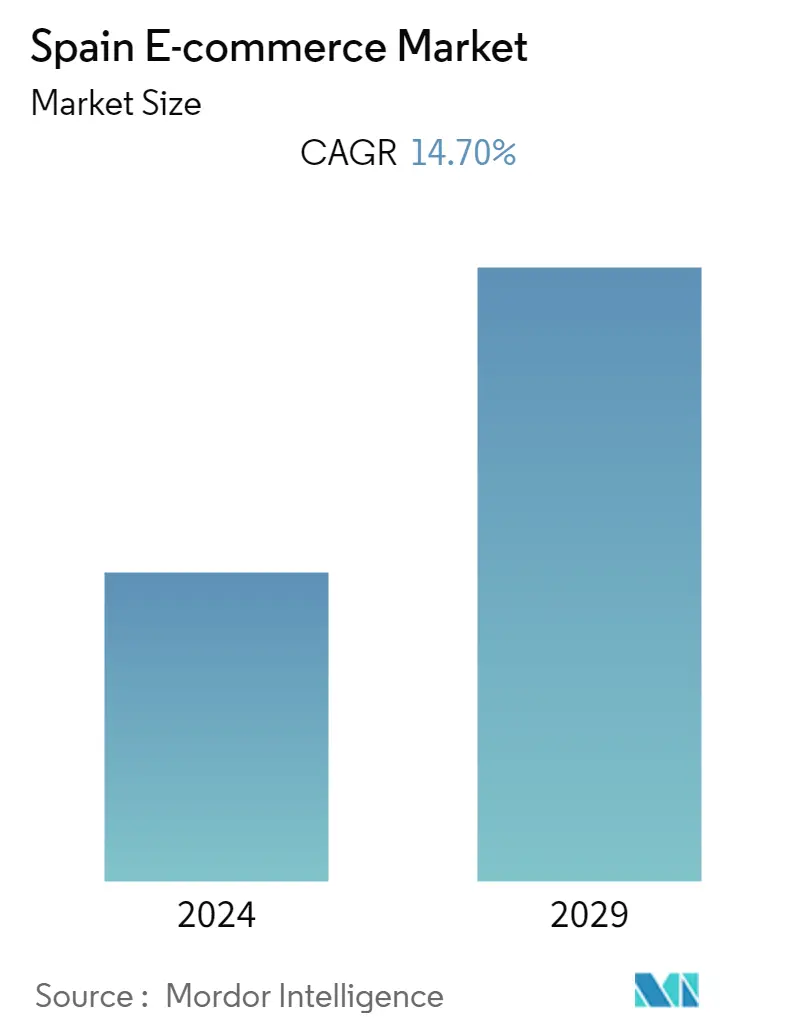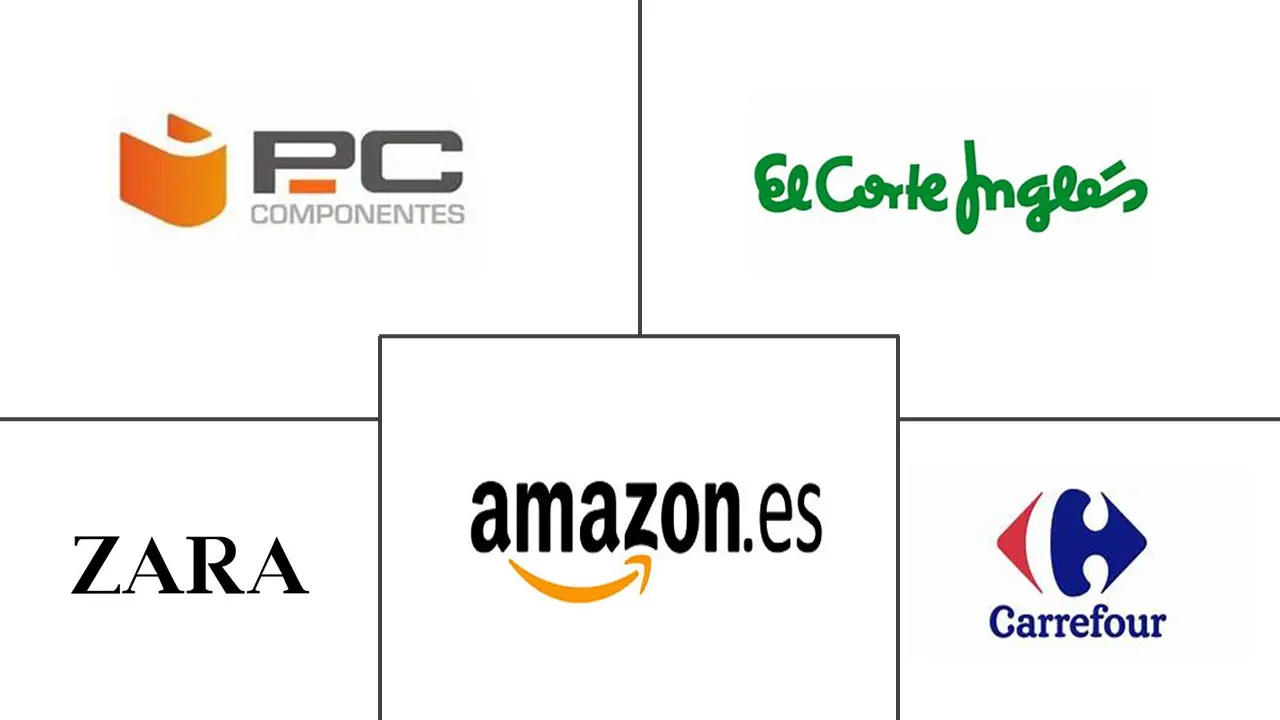Market Size of Spain E-commerce Industry

| Study Period | 2019 - 2029 |
| Base Year For Estimation | 2023 |
| Forecast Data Period | 2024 - 2029 |
| Historical Data Period | 2019 - 2022 |
| CAGR | 14.70 % |
| Market Concentration | Medium |
Major Players
*Disclaimer: Major Players sorted in no particular order |
Spain E-commerce Market Analysis
Spain's E-commerce Market is expected to register a CAGR above 14.7% during the forecast period, 2022-2027. Spain is one of Europe's largest markets for Fashion, Electronics & Media segments in revenue. This market is primarily driven by rising Internet and smartphone penetration, increasing reliance on social media to promote e-commerce platforms, expanding omnichannel business models, and introducing new payment modes.
- The top players in Spain's e-commerce market include various brands. This consists of the usual American giant like Amazon and eBay and some European heavyweights like Carrefour and Media Marketplace, which provides several local brands, making Spain one of the more diverse e-commerce markets.
- The market is expected to grow rapidly in the coming years Because of rising internet penetration. The use of smartphones and technological awareness among users has increased dramatically over the last decade, positively impacting the global market growth. Furthermore, advances in connectivity and high-speed internet availability, such as 3G, 4G, and 5G, significantly impact market growth.
- Correos is the most commonly offered delivery service provider among online stores in Spain. Even before inquiring about which service people use to transport their goods, 28 % named Correos as one of their providers. Furthermore, SEUR and UPS are among the top three shipping service providers offered by online retailers in Spain, with 21% and 18%, respectively.
- El Corte Inglés, eBay, Amazon, Mil Anuncios, Segunda Mano, Lets Bonus, Groupon, Bing, eBay, and Groupalia are popular online stores in Spain. With net e-commerce sales of US$ 4,416 million in 2020 generated in Spain, Amazon.es leads the Spanish e-commerce market, followed by Elcorteingles.es with US$ 1,862 million in 2020.
- COVID-19 has had a significant impact on the Spanish e-commerce market. E-commerce businesses faced many significant challenges, including disrupted supply chains, limited operations due to the lockdown, inventory management, and an overall lack of employees. In response to the COVID-19 pandemic, governments worldwide have imposed social distancing measures or temporarily closed non-essential businesses and taken other steps. As a result, e-commerce sales have increased. The pandemic has increased the use of online platforms in the Spain market.
- The COVID-19 pandemic has transformed Spanish consumer lifestyles and purchasing habits, allowing them to shift from traditional retail stores to online portals for goods and services. Many new omnichannel initiatives were launched in the first six months of 2020, resulting in smaller stores' closure and integration into more prominent format locations. Using the Zara App, the company launched a 'Store Mode,' allowing 25 stores across Spain to offer new features to customers, such as ordered products being ready for pick up within 30 minutes.
Spain E-commerce Industry Segmentation
E-commerce is the purchasing and selling of products and services over the Internet. It is conducted over computers, mobiles, tablets, and other smart devices. There are primarily two types of e-commerce, including Business-to-Consumer (B2C) and Business-to-Business (B2B).
The Spain E-commerce Market is segmented into B2C E-Commerce (Beauty and Personal Care, Consumer Electronics, Fashion and Apparel, Food and Beverage, Furniture and Home), and B2B E-Commerce.
| By B2C e-commerce | ||||||||
| Market size (GMV) for the period of 2017-2027 | ||||||||
|
Spain E-commerce Market Size Summary
The Spanish e-commerce market is experiencing significant growth, driven by factors such as increased internet and smartphone penetration, the rise of social media as a promotional tool, and the expansion of omnichannel business models. The market is characterized by a diverse range of players, including global giants like Amazon and eBay, as well as European companies such as Carrefour and Media Marketplace. The availability of advanced connectivity options like 3G, 4G, and 5G has further bolstered market expansion. The COVID-19 pandemic has accelerated the shift from traditional retail to online shopping, prompting the adoption of new technologies and strategies, such as the integration of AI and big data, to enhance consumer experiences. The pandemic also led to a surge in e-commerce sales, as consumers adapted to new purchasing habits.
Mobile commerce is a key growth area within the Spanish e-commerce sector, supported by high smartphone penetration and a preference for shopping via portable devices. The market is highly competitive and fragmented, with numerous players vying for market share, which is expected to lead to increased mergers, acquisitions, and partnerships. The introduction of new payment methods and logistics services, such as Amazon's Prime service, has become crucial for market participants. Additionally, the Spanish government is investing in the tourism sector's e-commerce infrastructure to further stimulate growth. Digital marketing remains a vital component, with significant investments aimed at enhancing online visibility and consumer engagement. As the market continues to evolve, companies are focusing on leveraging technology to meet the changing demands of Spanish consumers.
Spain E-commerce Market Size - Table of Contents
-
1. MARKET INSIGHTS
-
1.1 Market Overview
-
1.2 Industry Attractiveness-Porter's Five Forces Analysis
-
1.2.1 Bargaining Power of Suppliers
-
1.2.2 Bargaining Power of Buyers/Consumers
-
1.2.3 Threat of New Entrants
-
1.2.4 Threat of Substitute Products
-
1.2.5 Intensity of Competitive Rivalry
-
-
1.3 Key market trends and share of e-commerce of total Retail sector
-
1.4 Impact of COVID-19 on the e-commerce sales
-
-
2. MARKET SEGMENTATION
-
2.1 By B2C e-commerce
-
2.1.1 Market size (GMV) for the period of 2017-2027
-
2.1.2 Market Segmentation - by Application
-
2.1.2.1 Beauty & Personal Care
-
2.1.2.2 Consumer Electronics
-
2.1.2.3 Fashion & Apparel
-
2.1.2.4 Food & Beverage
-
2.1.2.5 Furniture & Home
-
2.1.2.6 Others (Toys, DIY, Media, etc.)
-
-
-
2.2 By B2B e-commerce
-
2.3 Market size for the period of 2017-2027
-
Spain E-commerce Market Size FAQs
What is the current Spain E-commerce Market size?
The Spain E-commerce Market is projected to register a CAGR of 14.70% during the forecast period (2024-2029)
Who are the key players in Spain E-commerce Market?
Amazon Spain, El Corte Ingles, PC Componentes and Carrefour Spain are the major companies operating in the Spain E-commerce Market.

